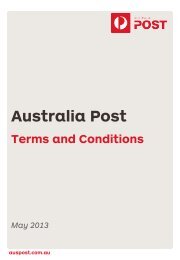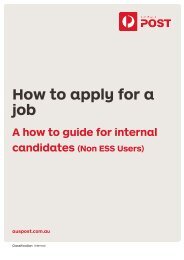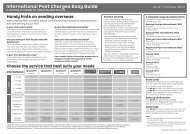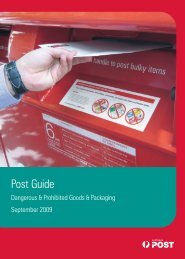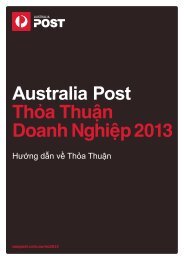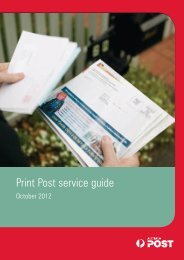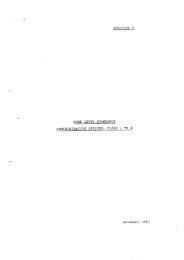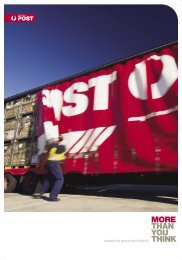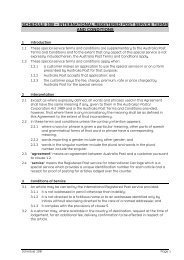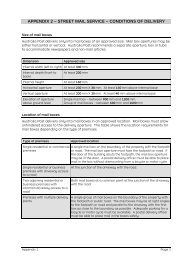Australia Post Annual Report 2008–09
Australia Post Annual Report 2008–09
Australia Post Annual Report 2008–09
Create successful ePaper yourself
Turn your PDF publications into a flip-book with our unique Google optimized e-Paper software.
Corporate responsibility Our people<br />
Occupational health and safety<br />
Our occupational health and safety (OH&S)<br />
program has helped <strong>Australia</strong> <strong>Post</strong> to achieve<br />
consistent year-on-year reductions in our lost<br />
time injury frequency rate (LTIFR) throughout<br />
the past decade.<br />
Unfortunately, this year, our LTIFR increased for<br />
the first time since 1997. The number of lost<br />
time injuries per million work hours was 7.1<br />
in <strong>2008–09</strong> (compared with 6.6 last year).<br />
The major factor contributing to this rise<br />
was an increase in the number of incidents<br />
involving our motorcycle posties.<br />
We maintained our focus on injury prevention<br />
and workplace safety through a range of<br />
initiatives, including:<br />
• training motorcyclists in safe riding<br />
behaviour, reinforcing existing safe work<br />
practices, including regular motorcycle<br />
maintenance inspections and undertaking<br />
risk reviews of motorcycle rounds<br />
• introducing a new uniform for our mail<br />
delivery staff that incorporates high levels<br />
of protection from solar UV, high levels<br />
of visibility, as well as thermal comfort<br />
while staff are performing mail delivery<br />
work outdoors<br />
• conducting the Safe <strong>Post</strong>ie Campaign<br />
to raise the public’s awareness about<br />
postie safety through newspaper and<br />
letterbox drop publicity<br />
• introducing a fatigue management plan<br />
for transport drivers, which outlines the<br />
corporation’s approach to controlling<br />
OH&S risks associated with heavy<br />
vehicle driver fatigue<br />
40<br />
Lost time injury frequency rate (LTIFR)<br />
per million work hours<br />
20<br />
15<br />
10<br />
5<br />
0<br />
1998–99<br />
1999–00<br />
2000–01<br />
2001–02<br />
2002–03<br />
2003–04<br />
2004–05<br />
2005–06<br />
2006–07<br />
2007–08<br />
7.1<br />
<strong>2008–09</strong><br />
<strong>Australia</strong> <strong>Post</strong> <strong>Annual</strong> <strong>Report</strong> <strong>2008–09</strong> | <strong>Report</strong> of operations<br />
• implementing new Health and Safety<br />
Management Arrangements (HSMAs) that<br />
enable managers to work in consultation<br />
with employees in effectively managing<br />
workplace health and safety hazards<br />
and risks.<br />
We continue to offer a range of health<br />
and wellbeing programs for staff, including a<br />
financial education program, confidential staff<br />
counselling service, Mensline (a telephone<br />
counselling service for men) and Staying<br />
Connected (workshops for fathers who<br />
have limited access to their children). We<br />
also conducted seminars during the year for<br />
managers and supervisors to improve their<br />
awareness of domestic violence and mental<br />
health issues.<br />
Our successful rehabilitation and<br />
return-to-work program continued as well.<br />
Attendance<br />
Staff attendance at <strong>Australia</strong> <strong>Post</strong> remained<br />
steady during the year at 94.6 per cent (the<br />
same as last year). We continued our focus<br />
on managing absenteeism by using national<br />
attendance guidelines and focusing on<br />
initiatives that promote workforce flexibility<br />
and staff engagement.<br />
Labour relations<br />
Back in late 2007, the two key unions that<br />
represent our staff – the Communications<br />
Electrical Plumbing Union (CEPU) and the<br />
Community and Public Sector Union (CPSU) –<br />
withdrew their support for our seventh<br />
enterprise bargaining agreement (EBA7).<br />
In the absence of a new enterprise agreement,<br />
EBA6 continues to apply to our employees,<br />
and it establishes the framework for our<br />
consultations with the CEPU and the CPSU.<br />
Approximately 96 per cent of our staff are<br />
covered by this collective agreement.<br />
Despite the unions’ decision to withdraw their<br />
support for EBA7, <strong>Australia</strong> <strong>Post</strong> has continued<br />
to pay the salary increases that were outlined<br />
in the original EBA7 pay offer. Eligible staff,<br />
therefore, received a 4 per cent pay rise in<br />
August 2008. All eligible staff are also due<br />
to receive a $500 performance bonus in<br />
September 2009 as reward for their role<br />
in helping the corporation to exceed its<br />
94 per cent target for on-time letter<br />
delivery during <strong>2008–09</strong>.<br />
Staff engagement<br />
A total of 25,587 staff (73.5 per cent of<br />
all our people) voluntarily participated in the<br />
Staff Attitude Survey that we conducted in<br />
February 2009. The survey results showed<br />
significant improvement in staff attitudes<br />
when compared with previous years. In<br />
particular, 70 per cent of staff responded<br />
favourably to the questions related to<br />
employee engagement.<br />
The future<br />
As we seek to improve employee retention<br />
and attendance rates, we will endeavour to<br />
create greater workforce flexibility over the<br />
coming year. We will also renew our focus on<br />
occupational health and safety in an effort to<br />
once again reduce the incidence of lost time<br />
injuries in our workplaces.




